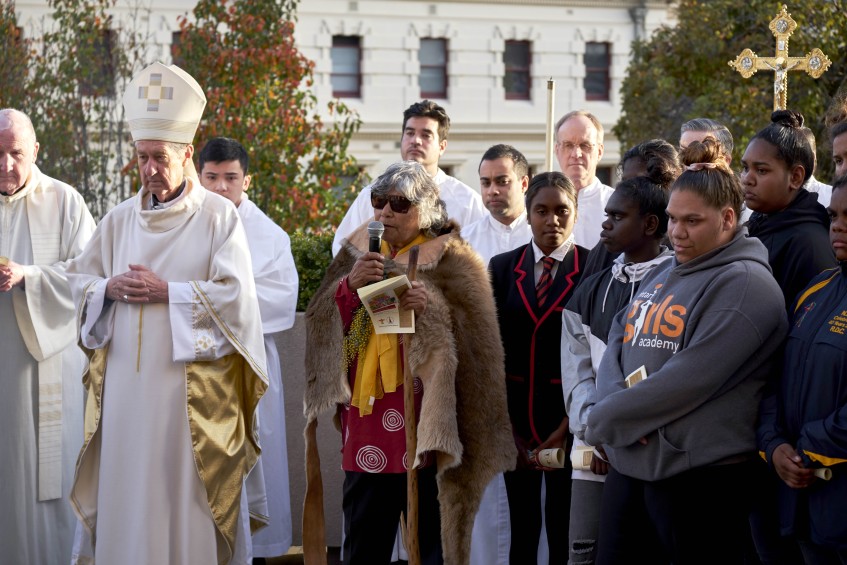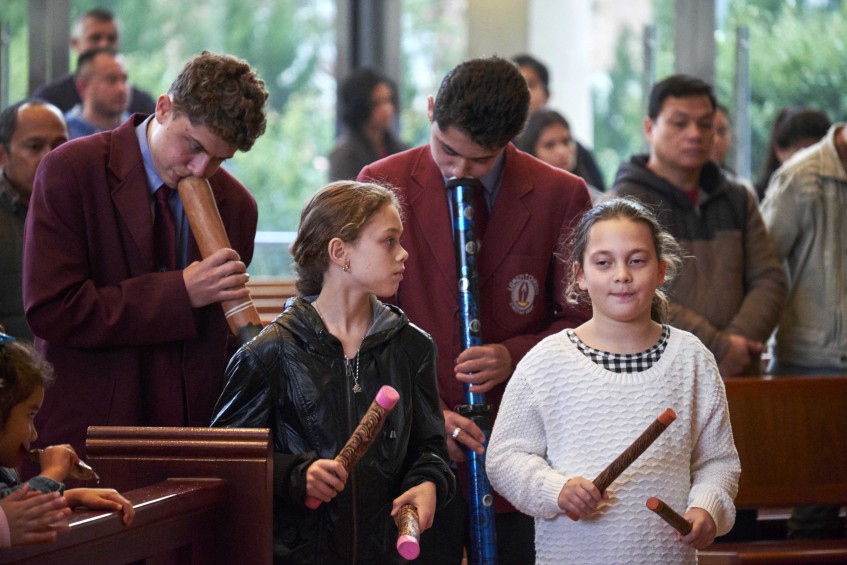‘Because of Her, We Can’ appreciates the role of women at NAIDOC celebrations

Australian Aboriginal elder Theresa Walley led the Welcome to Country to commence the 2018 NAIDOC Week Mass at St Mary’s Cathedral on 22 July 2018. Photo: Ron Tan.
By Amanda Murthy
The Australian Aboriginal community have last week come together during a Mass at St Mary’s Cathedral to celebrate the conclusion of National Aboriginal and Torres Strait Islanders (NATSIC) Week 2018.
The festivities organised by the Aboriginal Catholic Ministry (ACM) began with a traditional “Welcome to Country” and smoking ceremony at the Cathedral forecourt, led by elders Therese Walley and Ben Taylor.
The Mass – celebrated by Emeritus Archbishop Barry Hickey – began with the entrance hymn The Lord is my Shepherd followed by a blessing and sprinkling of water accompanied by the sounds of a digeridoo, played by Gosnells Lumen Christi College students Thairon and Brandon Jansen.

Archbishop Emeritus Barry Hickey encouraged the congregation to come together as one body in Christ during the 2018 NAIDOC Week Mass. Photo: Ron Tan.
In his homily, Archbishop Emeritus Hickey addressed the hardships and political struggles that the Aboriginal and Torres Strait Islander people have endured in finding their place in society.
Archbishop Emeritus Hickey spoke about the letter of St Paul to the Ephesians, when St Paul pleaded that all the different nations be one in Christ, adding that “Jesus had many times prayed about all His people coming together as one, taking for instance, at the Last Supper, when Jesus broke the bread and invited His disciples to be one with Christ”.
“The inclusion of diversity is part of the Church, and they are included in the one family of God - this is a reality we need to promote and make even more real than it is today,” he said.

Two women from the Aboriginal community place the message sticks at the altar. In Aboriginal culture, message sticks are communication tools which display messages of faith, culture, healing, reconciliation, living the mercy, and justice of God. Photo: Ron Tan.
Archbishop Emeritus Hickey explained that in the Gospel, Jesus healed the sick, blind, possessed and those addicted to wealth and embraced them.
“This shows us the love and compassion Jesus had for people. He sees inside our hearts, He knows our struggles, the crosses that we bear, and He says to each and every one of us: ‘Come to me, all you who are weary and burdened, and I will give you rest, peace, joy, hope, and salvation to the fullest’.”

Gosnells Lumen Christi College students Thairon and Brandon Jansen played the digeridoo throughout parts of the Mass. Photo: Ron Tan.
The prayers of the faithful focused on special intentions for the Aboriginal and Torres Strait Island community, highlighting homelessness, abuse, loneliness, and women.
ACM Director Vicky Burrows thanked the congregation for their support and said she was pleased with the turnout this year.
Ms Burrows said she hopes more people will be inspired to attend in the coming years.

Parishioners gather after Mass for a dinner featuring traditional Aboriginal cuisine, sponsored by the Aboriginal community. Photo: Ron Tan.
The theme this year is a tribute to the women of the Aboriginal and Torres Strait Islander who play an important role as caregivers and leaders of their families and their communities, Ms Burrows told The eRecord.
“Above all, we also give thanks to Mother Mary, and recognise her strength and courage as the mother of Christ,” she concluded.
The NAIDOC week celebrations are held across Australia every July to celebrate the culture, history and achievements of Aboriginal and Torres Strait Islander community. The theme this year “Because of Her, We Can” paid tribute to the contributions and influences of Aboriginal and Torres Strait Islander women at local, state and national levels, who were regarded as “unsung” and “diminished” figures in society.
